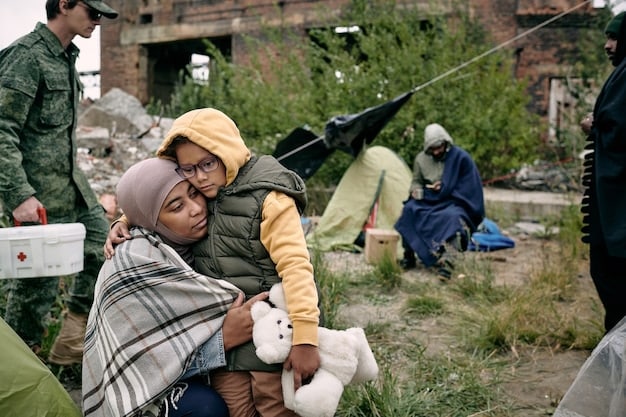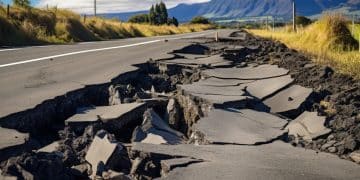Is Your Humanitarian Organization Ready for the 2025 Disaster Response Framework?

Is your humanitarian organization prepared for the 2025 National Disaster Response Framework? Understanding and adapting to the updated framework is critical for effective disaster response, ensuring your organization can provide timely and relevant aid when and where it’s needed most.
The landscape of disaster response is constantly evolving, and with 2025 on the horizon, it’s imperative that your humanitarian organization is fully prepared for the updated National Disaster Response Framework. Is your organization truly ready for the challenges and changes ahead? Don’t wait until it’s too late; proactive preparation is key to saving lives and minimizing suffering in times of crisis.
Understanding the Current National Disaster Response Framework
Before diving into the specifics of the 2025 updates, it’s crucial to have a solid understanding of the current National Disaster Response Framework (NDRF). This framework serves as a guide for how the nation responds to all types of disasters and emergencies, ensuring a coordinated and effective response.
The NDRF outlines the key principles, roles, and responsibilities for disaster response across various levels of government, the private sector, and nongovernmental organizations (NGOs). Its primary goal is to save lives, reduce suffering, and protect property and the environment.
Key Components of the Current Framework
The current NDRF is built on several key components that facilitate effective disaster response. These components include:
- Emergency Support Functions (ESFs): These are organized groups of government and private sector entities that provide coordinated assistance in specific areas, such as transportation, communications, and public health.
- Incident Command System (ICS): This standardized management system ensures a coordinated and hierarchical approach to managing disaster response efforts.
- National Incident Management System (NIMS): NIMS provides a consistent nationwide template to enable federal, state, tribal, and local governments, private-sector and nongovernmental organizations to work together to prepare for, prevent, respond to, recover from, and mitigate domestic incidents, regardless of cause, size, location, or complexity.
The Role of Humanitarian Organizations
Humanitarian organizations play a vital role within the NDRF, often filling critical gaps in services and providing specialized expertise. They work alongside government agencies and other stakeholders to deliver aid, support recovery efforts, and advocate for affected communities.

Understanding the NDRF allows humanitarian organizations to align their efforts, coordinate effectively with other responders, and maximize their impact on the ground. It’s about being a prepared and proactive member of the disaster response ecosystem.
In summary, the current National Disaster Response Framework provides a structured approach to disaster response that involves various entities, including humanitarian organizations. Awareness of key components and roles is crucial for effective collaboration and aid delivery.
What to Expect in the Updated 2025 NDRF
As we approach 2025, several updates and refinements are expected in the National Disaster Response Framework. These changes reflect lessons learned from past disasters, technological advancements, and evolving societal needs. Staying informed about these updates is critical for humanitarian organizations aiming to remain effective and relevant.
The updated 2025 NDRF is anticipated to address emerging challenges and incorporate innovative approaches to disaster management. Key areas of focus may include climate change resilience, cybersecurity threats, and community-based preparedness.
Anticipated Changes and Focus Areas
While the specifics of the 2025 NDRF are still being finalized, several key areas are likely to see significant changes:
- Integration of climate change considerations: The updated framework may emphasize the need to address the increasing frequency and intensity of climate-related disasters.
- Enhanced cybersecurity protocols: Protecting critical infrastructure and communication systems from cyberattacks during disasters will likely be a priority.
- Increased emphasis on community resilience: Empowering local communities to prepare for and respond to disasters on their own is gaining traction.
How These Updates May Affect Humanitarian Organizations
The updates in the 2025 NDRF will have direct implications for humanitarian organizations. They may need to adapt their strategies, training programs, and partnerships to align with the new framework.
For instance, organizations may need to invest in technologies that enhance communication and coordination during disasters. They may also need to develop expertise in addressing the specific needs of vulnerable populations in the context of climate change.
Understanding the expected changes in the 2025 NDRF allows humanitarian organizations to proactively prepare and adapt. Being ready for these modifications will ensure continued effectiveness in disaster response.
In conclusion, the updated 2025 National Disaster Response Framework is anticipated to include changes related to climate change, cybersecurity, and community resilience, which will require humanitarian organizations to adjust their strategies and operations accordingly.
Assessing Your Organization’s Current Preparedness
Evaluating your humanitarian organization’s current level of preparedness is the first step toward ensuring readiness for the updated 2025 NDRF. This assessment should consider various aspects of your organization, including its resources, capabilities, and partnerships.
A comprehensive preparedness assessment identifies strengths, weaknesses, opportunities, and threats (SWOT) within your organization. This analysis helps in developing a targeted plan for improvement and adaptation.
Key Areas to Evaluate:
- Resource Availability: Evaluate the availability of essential resources, such as funding, personnel, equipment, and supplies.
- Training and Expertise: Assess the level of training and expertise among staff and volunteers, ensuring they are equipped to handle diverse disaster scenarios.
- Partnerships and Coordination: Examine existing partnerships with other organizations and agencies, and evaluate the effectiveness of coordination mechanisms.
Tools and Methods for Assessment
Several tools and methods can be used to assess your organization’s preparedness, including:
- Self-Assessment Questionnaires: These questionnaires help evaluate various aspects of preparedness, such as planning, training, and resource management.
- Simulations and Drills: Conducting simulations and drills allows organizations to test their response capabilities and identify areas for improvement.

By conducting a thorough assessment of your organization’s current preparedness, you can identify gaps and areas for improvement. This knowledge is essential for developing a targeted plan to enhance readiness for the updated 2025 NDRF.
In essence, assessing your organization’s readiness is about honestly evaluating your capabilities and resources. Armed with this knowledge, you can take concrete steps to strengthen your capacity for disaster response.
Developing a Strategic Plan for Adaptation
Once you’ve assessed your organization’s preparedness, the next step is to develop a strategic plan for adapting to the updated 2025 National Disaster Response Framework. This plan should outline specific actions, timelines, and responsibilities for enhancing your organization’s capabilities.
A well-defined strategic plan provides a roadmap for navigating the changes and challenges associated with the updated NDRF. It should align with your organization’s mission and values, while also addressing the specific needs of the communities you serve.
Key Elements of a Strategic Plan
- Goals and Objectives: Clearly define the goals and objectives you want to achieve in adapting to the updated NDRF.
- Action Steps: Outline specific actions that need to be taken to achieve each goal and objective.
- Resource Allocation: Determine how resources will be allocated to support the implementation of the strategic plan.
Integrating the Updated NDRF into Your Organization
Integrating the updated NDRF into your organization involves several steps, including:
- Training and Education: Provide training and education to staff and volunteers on the updated framework and its implications for their roles.
- Policy and Procedure Updates: Review and update your organization’s policies and procedures to align with the updated NDRF.
Developing a strategic plan is vital for adapting to the updated NDRF. This plan should provide a clear roadmap for achieving your goals and objectives, while also ensuring alignment with your organization’s mission and values.
To summarize, creating a strategic adaptation plan involves setting clear goals, defining actionable steps, allocating resources effectively, and integrating the NDRF updates into your organization’s policies and training programs.
Investing in Training and Capacity Building
Investing in training and capacity building is essential for equipping your humanitarian organization with the skills and knowledge needed to effectively respond to disasters under the updated 2025 NDRF. This investment should focus on enhancing the competencies of staff and volunteers across various areas.
Training and capacity building programs should be tailored to the specific needs of your organization and the communities you serve. They should also be continuously updated to reflect evolving best practices and emerging challenges.
Areas to Prioritize for Training
- Emergency Response Skills: Training in first aid, search and rescue, and damage assessment are crucial for initial disaster response.
- Communication and Coordination: Effective communication and coordination are essential for seamless collaboration during disasters.
- Cultural Competency: Understanding and respecting cultural differences can enhance the effectiveness of aid delivery.
Utilizing Technology for Training
Technology can play a significant role in enhancing training and capacity building efforts. Online courses, simulations, and virtual reality can provide engaging and cost-effective learning experiences.
By investing in training and capacity building, you can ensure that your organization is well-prepared to respond effectively to disasters under the updated 2025 NDRF. This investment will improve your organization’s capabilities and enhance its impact on affected communities.
In short, prioritize training in emergency response, communication, and cultural competency. Leveraging technology can make training more effective and accessible.
Strengthening Partnerships and Collaboration
Strengthening partnerships and collaboration with other organizations and agencies is vital for maximizing the effectiveness of disaster response efforts. Collaboration allows for the pooling of resources, sharing of expertise, and coordinated action to address the complex challenges of disaster situations.
Effective partnerships are built on trust, mutual respect, and a shared commitment to serving affected communities. They require clear communication channels, well-defined roles and responsibilities, and a willingness to work together toward common goals.
Identifying Potential Partners
- Government Agencies: Partnering with government agencies can provide access to resources, information, and support.
- Other Humanitarian Organizations: Collaborating with other humanitarian organizations can enhance capacity, avoid duplication of efforts, and ensure comprehensive coverage of needs.
- Private Sector Companies: Engaging with private sector companies can provide access to specialized expertise, technology, and logistical support.
Building and Maintaining Effective Partnerships
Building and maintaining effective partnerships requires ongoing effort and attention. This includes:
- Regular Communication: Establish regular communication channels to share information, coordinate activities, and address emerging issues.
- Joint Planning and Training: Engage in joint planning and training activities to build trust, foster teamwork, and enhance preparedness.
Strengthening partnerships and collaboration with other organizations and agencies is critical for maximizing the effectiveness of disaster response efforts. These partnerships leverage diverse resources and expertise to better serve affected communities.
In brief, identify potential partners in government, among other humanitarian organizations, and within the private sector. Then, focus on clear communication, joint training exercises, and transparent roles to develop robust and efficient collaborations.
| Key Aspect | Brief Description |
|---|---|
| ⚠️ NDRF Updates | Understanding anticipated changes in the 2025 National Disaster Response Framework. |
| 🤝 Partnerships | Enhancing collaboration with government, NGOs, and private sector. |
| 📚 Training | Investing in emergency response, communication, and cultural competency skills. |
| 📊 Preparedness | Assessing current capabilities and resources for disaster response. |
Frequently Asked Questions
▼
The NDRF is a guide for how the nation responds to all types of disasters and emergencies. It outlines key principles, roles, and responsibilities across various levels of government and the private sector.
▼
The updates reflect lessons learned from past disasters, incorporate technological advancements, and address evolving societal needs. Preparing helps organizations remain effective and relevant.
▼
Anticipated changes include integrating climate change considerations, enhancing cybersecurity protocols, and increasing emphasis on community resilience.
▼
Evaluate resource availability, training and expertise, and partnerships and coordination. Use tools like self-assessment questionnaires and simulations.
▼
Include clearly defined goals and objectives, specific action steps, resource allocation strategies, and how to integrate NDRF updates into policies and training.
Conclusion
Preparing your humanitarian organization for the updated 2025 National Disaster Response Framework is not merely a matter of compliance but a critical step towards ensuring that you can effectively serve communities in times of crisis. It requires a proactive approach, a commitment to training and capacity building, and strong partnerships within the disaster response ecosystem. By taking these steps, you can ensure that your organization is ready to meet the challenges of tomorrow and make a meaningful difference in the lives of those affected by disasters. Is your humanitarian organization prepared for the updated 2025 National Disaster Response Framework?





